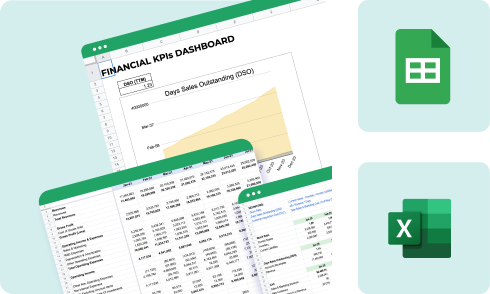What's Inside
Our free Financial KPI Dashboard Template is designed for FP&A professionals seeking a robust, user-friendly platform that delivers immediate and strategic financial insights.
This template includes the following bottom-line margin details:
Profitability trends
- Quick Ratio
- DSO (Daily Sales Outstanding)
- Customer Acquisition Costs (CAC)
Model components
- Revenue
- Financial metrics
- OpEx analysis
- Drivers
How to use the template
This template is built to give you a starting point for creating dashboards and advanced visualizations within a spreadsheet environment. The template contains visuals tied to data tables at the bottom of each page.
To use the model:
- Review each tab to evaluate the relevance of each visualization for you.
- Change the accounts, departments, products, markets, etc to match your specific business where appropriate.
- Copy data into the template into the proper tables. Feel free to create a historical data tab to keep all of the prior periods as well.
- Validate the visuals appropriately reflect your data.
Use with Cube
For those already using Cube software,, you’ll find integration is a breeze. In just two quick minutes, you can sync this template with your existing setup and start leveraging its full potential.
Here’s how to get started.
Step 1: Open the template in Excel or Sheets.
Step 2: Customize the row and column headers to match your Cube's dimensions and filters.
Step 3: Select the range where you want to fetch your data.
Step 4: Fetch your data.
Cube connects to the given spreadsheet and the structure of your tables and can populate the values for you each month, and also will activate the use of the dropdowns.
.gif?width=600&name=CreateTemplate%20(1).gif)
All About KPIs
For any business, the best KPIs help companies determine what they're doing well and where they need to improve.
KPIs are metrics that provide insights into a business's underlying financial and operational strength. They can be based on any data important to a company, such as sales per square foot of retail space, click-through rate for web ads, or accounts closed per salesperson.
Many KPIs are financial ratios that highlight important relationships in data, such as the ratio of profit to revenue or the ratio of current assets to current liabilities.
A single KPI measurement can provide a useful snapshot of the business's health at a specific time.
KPIs are even more powerful when they're used to analyze trends over time to measure progress against targets or compare the business with similar companies.
A KPI is even more valuable when you place it in context with other meaningful KPIs.
Financial KPIs dashboard best practices
From selecting the right metrics to ensuring data security, these guidelines will help you build a dashboard that is both informative and empowers you to make strategic decisions with confidence.
Identify Key Financial Goals: Establish what financial outcomes are most critical to your business strategy to determine relevant KPIs.
Select Relevant KPIs: Choose KPIs that directly reflect your company's financial health, like cash flow, profit margins, and revenue growth.
Prioritize Data Accuracy: Ensure that the data feeding into your KPIs is accurate and from reliable sources.
Automate Data Collection: Reduce manual data entry with automation to save time and reduce errors.
Enable Drill-Down Features: Allow users to explore deeper into the data behind the KPIs for a comprehensive analysis.
Ensure Scalability: Make sure your dashboard can grow with your business, accommodating more data and complex analyses over time.
Regularly Review and Update KPIs: As business goals evolve, revisit and revise your KPIs to stay aligned with current objectives.
Maintain Security Protocols: Keep financial data secure with proper access controls and encryption where necessary.
Additional resources
- 10 KPIs finance leaders need to track for organizational health
- PSA: Not all metrics are KPIs - best practices
- Calculating DPO vs. DSO
- Designing & presenting effective financial reporting dashboards
Get started
Ready to take control of your financial analysis? Download our free template now and start making more informed decisions today.


.png)



